ED#179 : Why It's Really Time To Ditch (And Strip) The Short Filename
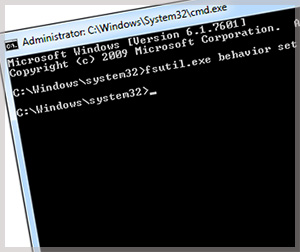 To be honest, it's long past time for us to ditch the short filename, or as it's known in geeky circles - the 8.3 filename format. Microsoft has kept it for compatibility reason, but that reason has long outstayed its welcome.
To be honest, it's long past time for us to ditch the short filename, or as it's known in geeky circles - the 8.3 filename format. Microsoft has kept it for compatibility reason, but that reason has long outstayed its welcome.
Microsoft first introduced the long filename (LFN) in Windows NT 3.5, but twenty years later, NTFS continues to generate a short filename for every file you write today. This degrades the file system's performance because it forces NTFS to create two file entries for each file, instead of just one. In addition, every time a file with a long filename is created in a directory, NTFS must look-up every short filenames in that directory in order to generate a new, unique short filename for the new file.
Needless to say, this creates a lot of extra work for NTFS, all because Microsoft wants to play safe and ensure that decrepit software from the 1990s can identify and read files with long filenames. Unless you are using old software from when Keanu Reeves and Sandra Bullock first broke out into stardom in Speed, you should disable the automatic generation of the 8.3 short filename.
Doing so will give a kick to the NTFS file system's performance. In addition, if you are using an SSD, disabling the generation of the 8.3 short filename would also help maintain the SSD's performance and lifespan by reducing the amount of writes to it.
There are two ways to do this, which we will examine below. After that, please make sure you go to the next page for instructions on how to strip the short filenames from your system.
How to add cloud storage services to Microsoft Office 2013
Using The Command Prompt
-
Open up the Command Prompt in Administrator mode. You can do this by searching for "cmd" and right clicking on it and select "Run as administrator".

- Type "fsutil.exe behavior set disable8dot3 1" and press Enter.
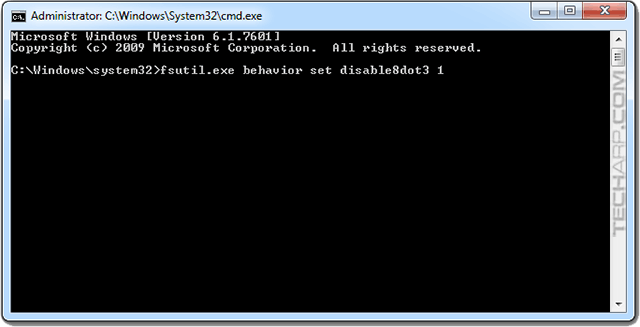
-
If you do not see any error messages after you press Enter, then you have successfully disabled short file name creation in Microsoft Windows.

The change using this method takes immediate effect, and no restart is required. So this is the preferred method, if you are comfortable using the command prompt.
Should you select MBR or GPT when you install a new drive?
Using The Registry Editor
- Open the Registry Editor by typing "regedit" in the Start search box and clicking on regedit.exe as shown below, or going to drive:\Windows\regedit.exe.

-
In the Registry Editor, go to HKEY_LOCAL_MACHINE\SYSTEM\CurrentControlSet\Control\FileSystem and look for NtfsDisable8dot3NameCreation.
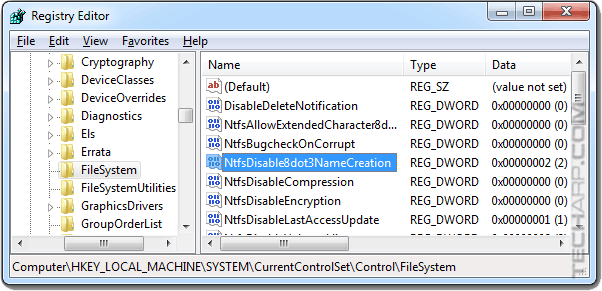
-
By default, the NtfsDisable8dot3NameCreation value is set to 2 (enabled). Just double-click on theNtfsDisable8dot3NameCreation option to edit it. Then type 1 into the Value data box and click OK.
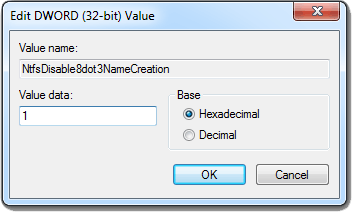
-
You should see that NtfsDisable8dot3NameCreation's value is now 1 (disabled).
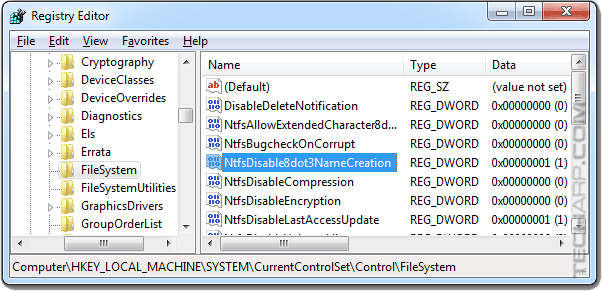
- Close the Registry Editor, and restart Windows for the changes to take effect.
Please note that this is only the first part. To obtain the full performance benefit of disabling the short filename format, you will need to strip your system of the old short filenames as well. Go on to the next page for the instructions...
| If you like this article, please share it! -> |
Tech Explainer For compatibility with old applications that can only understand the 8.3 short filename format, Microsoft Windows will automatically create a short filename for every file that does not conform to the short filename format. This degrades the file system's performance because it forces NTFS to create two file entries for each file, instead of just one. In addition, every time a file with a long filename is created in a directory, NTFS must look-up every short filenames in that directory in order to generate a new, unique short filename for the new file. Whether you are using fsutil (File System Utility) or editing the NtfsDisable8dot3NameCreation value in the registry manually, the options are exactly the same :
Please note though that if you are still using very old applications that only support the 8.3 short filename format, disabling the NTFS short name creation will prevent those applications from locating files and directories that use long file names. |
Support Tech ARP!
If you like our work, you can help support out work by visiting our sponsors, participate in the Tech ARP Forums, or even donate to our fund. Any help you can render is greatly appreciated!
Page |
How To Ditch (And Strip) The Short Filename |
1 |
How To Disable The Creation Of Short Filenames |
2 |
Why You Should Also Strip The Existing Short Filenames |
Support us by buying from Amazon.com! |
|
| Grab a FREE 30-day trial of Amazon Prime for free shipping, instant access to 40,000 movies and TV episodes and the Kindle Owners' Lending Library! | |








 Add to Reddit
Add to Reddit
